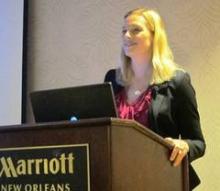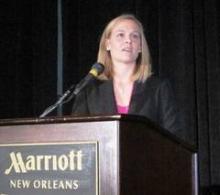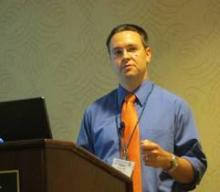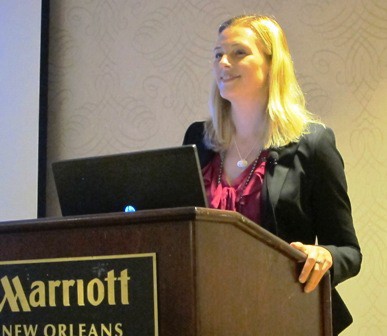User login
NEW ORLEANS – Inpatient staffing in the wake of tighter residency work hours, avoiding premature diagnostic closure, and hospitalist perceptions of resident effects on quality of care and costs were tackled in a trio of oral abstracts presented at Pediatric Hospital Medicine 2013.
Work-rules effects
A Web-based survey of 152 pediatric residency programs in the United States revealed marked variation in how programs have responded after the Accreditation Council for Graduate Medical Education mandated new residency work hour restrictions in July 2011.
The most common changes were the addition of a resident night-float system and an increase in the number of attending physicians present at night, primarily in the form of pediatric hospitalists and pediatric intensivists, said Dr. Jennifer Oshimura, with Indiana University, Riley Hospital for Children, Indianapolis.
The number of programs using a night-float system increased from 43% to 71% after the new residency work hours, while the number of programs utilizing resident admission caps increased only slightly, from 12% to 15%.
In all, 23% of programs increased night in-house attending coverage following the work-hour restrictions.
Of these, 63% of programs increased their night-time attending coverage by adding pediatric hospitalists, 37% added pediatric intensivists, and 26% added neonatologists, Dr. Oshimura said.
Overall, the number of programs with pediatric hospitalist attendings in-house 24/7 rose from 16% to 20%, with 41% of programs planning to add this kind of coverage within the next 5 years.
Finally, only 12% of residency programs had no in-house attending coverage at night of any kind. This compares with 22% of programs in a previous study conducted by the group in 2010, before the work hour restrictions were in place, she noted.
The anonymous survey was sent to 198 pediatric residency training programs in the United States. The response rate was 77% (152/198), representing 7,828 pediatric residents or 79% of all pediatric residents in the United States.
The programs varied "drastically" in terms of size (average, 51.5 residents; range, 6-168) and average daily patient census per ward intern during the daytime (7.4 patients; range, 2-30), Dr. Oshimura remarked.
Premature closure
Results of a randomized trial show that simulated patient encounters can be used to help teach residents to avoid premature closure, or the tendency to accept a diagnosis before it is fully verified. The phenomenon prevents consideration of alternative diagnoses and is a common source of error in the care of inpatients.
"Premature closure can be summarized with the axiom: ‘When the diagnosis is made, the thinking stops,’ " Dr. Lauren Nassetta said at the meeting, sponsored by the Society of Hospital Medicine, the American Academy of Pediatrics, and the Academic Pediatric Association.
Dr. Nassetta and her colleagues at the University of Alabama at Birmingham randomly assigned 61 residents on inpatient pediatrics rotations to receive a text page with a brief description of a patient that contained either an incorrect diagnosis (stem A) or a symptom (stem B). The remainder of the case was carefully scripted and presented identically. Each of the 36 teams received 2 cases, and the cases were paired such that residents who received stem A for case 1 received stem B for case 2, and vice versa.
The cases involved common pediatric presentations for unusual reasons, such as a 14-month-old who presents with wheezing, secondary to congestive heart failure. For this case, the incorrect diagnosis was given as asthma.
The residents had 10 minutes to evaluate (history, physical exam, laboratory, and radiology) and treat simulated patients. High-fidelity mannequins were used to provide responses to the residents, while investigators played the role of nurse and family member.
Residents obtained significantly more elements in the evaluation when they received the symptom stem versus the incorrect diagnosis stem (63% vs. 55%; P less than .05), Dr. Nassetta said.
Residents given the symptom stem made the correct diagnosis 86% of the time, compared with only 69% of the time when given the incorrect diagnosis. The difference did not reach statistical significance at the group level (P = .16), but was significant on an individual participant level.
Still, the finding resulted in a relative risk of 2.2, "meaning that having the incorrect diagnosis made it twice as likely to miss the correct diagnosis," she said.
When data from individual participants were used in a multivariable logistic regression model, the adjusted odds ratio was 14.9 for making a correct diagnosis with the symptom stem vs. the incorrect diagnosis. The model adjusted for a variety of variables, including prior simulation time, case difficulty, level of training, program type, and confidence in independent care of patients.
Other predictors of making a correct diagnosis were obtaining a patient history (adjusted OR, 1.35) and obtaining an exam, labs, and radiology (aOR, 1.47).
"It’s obvious that residents lack insight into the causes of premature closure, but this does set us up for some opportunities for education," Dr. Nassetta said. "We can use simulated cases to demonstrate diagnostic error, discuss premature closure, and strategies for avoiding it."
Strategies she employs with residents include stressing the importance of the history and physical exam, having residents ask what doesn’t fit the diagnosis they have in mind, encouraging them to come up with one alternative diagnosis for every patient they see, and having residents describe rather than diagnose the patient at the time of handoff.
Are residents perceived as pricey?
Most pediatric hospitalists surveyed think residents increase the quality of care, but do so at increased cost to the hospital, according to a 15-item, anonymous, electronic survey of 127 pediatric hospitalists at 113 institutions.
Overall, 60% of respondents thought residents increase the quality of care, 23% said they have no impact, and 17% thought they actually decrease quality, said Dr. David P. Johnson, of Monroe Carell Jr. Children’s Hospital at Vanderbilt, Nashville, Tenn.
Subgroup analyses showed that 71% of hospitalists who always work with residents thought residents improve the quality of care, whereas only 43% of those who sometimes do, and 53% who never do felt the same (P less than .05).
Hospitalists affiliated with academic hospitals were also significantly more likely to say residents improve quality than were those at community hospitals (65% vs. 38%), he said.
In all, 72% of respondents said residents increase hospital costs, while 23% said they had no impact and 6% said they decrease costs.
In subgroup analyses, however, the perception that residents increase costs was similar no matter how much respondents worked with residents (71%, 71%, 73%; always, sometimes, never) or what their affiliation was (69% academic, 83% community), Dr. Johnson said.
One of the most intriguing findings from the survey was that 78% of hospitalists deny having any formal training in resource utilization, yet 91% think they provide cost-effective care, and 81% feel they are qualified to teach it, Dr. Johnson said.
"A gap exists between what we think we know and the training that we received," he said. "I don’t think that’s necessarily a bad thing, but it’s something we need to be cognizant of, both as we are taking care of our patients and teaching our residents."
Dr. Johnson hypothesized that informal training, reading, and being at the right place at the right time might explain some of the hospitalists’ confidence in the absence of formal training, but that experience may also matter.
Hospitalists with more than 10 years of experience were significantly more likely to say they had the knowledge to provide cost-effective care, compared with those with 6-10 years of experience or 5 years or less (100% vs. 91% vs. 85%; P less than .05). A similar, but nonsignificant, trend was present when respondents were asked whether they were qualified to teach cost-effective care (93% vs. 77% vs. 75%).
At baseline, 31% of respondents had been in practice for more than 10 years, 28% for 6-10 years, and 41% for 0-5 years. The majority had an academic affiliation (81%); 55% always worked with residents, 33% sometimes, and 12% never.
Dr. Oshimura, Dr. Nassetta, and Dr. Johnson reported having no financial disclosures.
NEW ORLEANS – Inpatient staffing in the wake of tighter residency work hours, avoiding premature diagnostic closure, and hospitalist perceptions of resident effects on quality of care and costs were tackled in a trio of oral abstracts presented at Pediatric Hospital Medicine 2013.
Work-rules effects
A Web-based survey of 152 pediatric residency programs in the United States revealed marked variation in how programs have responded after the Accreditation Council for Graduate Medical Education mandated new residency work hour restrictions in July 2011.
The most common changes were the addition of a resident night-float system and an increase in the number of attending physicians present at night, primarily in the form of pediatric hospitalists and pediatric intensivists, said Dr. Jennifer Oshimura, with Indiana University, Riley Hospital for Children, Indianapolis.
The number of programs using a night-float system increased from 43% to 71% after the new residency work hours, while the number of programs utilizing resident admission caps increased only slightly, from 12% to 15%.
In all, 23% of programs increased night in-house attending coverage following the work-hour restrictions.
Of these, 63% of programs increased their night-time attending coverage by adding pediatric hospitalists, 37% added pediatric intensivists, and 26% added neonatologists, Dr. Oshimura said.
Overall, the number of programs with pediatric hospitalist attendings in-house 24/7 rose from 16% to 20%, with 41% of programs planning to add this kind of coverage within the next 5 years.
Finally, only 12% of residency programs had no in-house attending coverage at night of any kind. This compares with 22% of programs in a previous study conducted by the group in 2010, before the work hour restrictions were in place, she noted.
The anonymous survey was sent to 198 pediatric residency training programs in the United States. The response rate was 77% (152/198), representing 7,828 pediatric residents or 79% of all pediatric residents in the United States.
The programs varied "drastically" in terms of size (average, 51.5 residents; range, 6-168) and average daily patient census per ward intern during the daytime (7.4 patients; range, 2-30), Dr. Oshimura remarked.
Premature closure
Results of a randomized trial show that simulated patient encounters can be used to help teach residents to avoid premature closure, or the tendency to accept a diagnosis before it is fully verified. The phenomenon prevents consideration of alternative diagnoses and is a common source of error in the care of inpatients.
"Premature closure can be summarized with the axiom: ‘When the diagnosis is made, the thinking stops,’ " Dr. Lauren Nassetta said at the meeting, sponsored by the Society of Hospital Medicine, the American Academy of Pediatrics, and the Academic Pediatric Association.
Dr. Nassetta and her colleagues at the University of Alabama at Birmingham randomly assigned 61 residents on inpatient pediatrics rotations to receive a text page with a brief description of a patient that contained either an incorrect diagnosis (stem A) or a symptom (stem B). The remainder of the case was carefully scripted and presented identically. Each of the 36 teams received 2 cases, and the cases were paired such that residents who received stem A for case 1 received stem B for case 2, and vice versa.
The cases involved common pediatric presentations for unusual reasons, such as a 14-month-old who presents with wheezing, secondary to congestive heart failure. For this case, the incorrect diagnosis was given as asthma.
The residents had 10 minutes to evaluate (history, physical exam, laboratory, and radiology) and treat simulated patients. High-fidelity mannequins were used to provide responses to the residents, while investigators played the role of nurse and family member.
Residents obtained significantly more elements in the evaluation when they received the symptom stem versus the incorrect diagnosis stem (63% vs. 55%; P less than .05), Dr. Nassetta said.
Residents given the symptom stem made the correct diagnosis 86% of the time, compared with only 69% of the time when given the incorrect diagnosis. The difference did not reach statistical significance at the group level (P = .16), but was significant on an individual participant level.
Still, the finding resulted in a relative risk of 2.2, "meaning that having the incorrect diagnosis made it twice as likely to miss the correct diagnosis," she said.
When data from individual participants were used in a multivariable logistic regression model, the adjusted odds ratio was 14.9 for making a correct diagnosis with the symptom stem vs. the incorrect diagnosis. The model adjusted for a variety of variables, including prior simulation time, case difficulty, level of training, program type, and confidence in independent care of patients.
Other predictors of making a correct diagnosis were obtaining a patient history (adjusted OR, 1.35) and obtaining an exam, labs, and radiology (aOR, 1.47).
"It’s obvious that residents lack insight into the causes of premature closure, but this does set us up for some opportunities for education," Dr. Nassetta said. "We can use simulated cases to demonstrate diagnostic error, discuss premature closure, and strategies for avoiding it."
Strategies she employs with residents include stressing the importance of the history and physical exam, having residents ask what doesn’t fit the diagnosis they have in mind, encouraging them to come up with one alternative diagnosis for every patient they see, and having residents describe rather than diagnose the patient at the time of handoff.
Are residents perceived as pricey?
Most pediatric hospitalists surveyed think residents increase the quality of care, but do so at increased cost to the hospital, according to a 15-item, anonymous, electronic survey of 127 pediatric hospitalists at 113 institutions.
Overall, 60% of respondents thought residents increase the quality of care, 23% said they have no impact, and 17% thought they actually decrease quality, said Dr. David P. Johnson, of Monroe Carell Jr. Children’s Hospital at Vanderbilt, Nashville, Tenn.
Subgroup analyses showed that 71% of hospitalists who always work with residents thought residents improve the quality of care, whereas only 43% of those who sometimes do, and 53% who never do felt the same (P less than .05).
Hospitalists affiliated with academic hospitals were also significantly more likely to say residents improve quality than were those at community hospitals (65% vs. 38%), he said.
In all, 72% of respondents said residents increase hospital costs, while 23% said they had no impact and 6% said they decrease costs.
In subgroup analyses, however, the perception that residents increase costs was similar no matter how much respondents worked with residents (71%, 71%, 73%; always, sometimes, never) or what their affiliation was (69% academic, 83% community), Dr. Johnson said.
One of the most intriguing findings from the survey was that 78% of hospitalists deny having any formal training in resource utilization, yet 91% think they provide cost-effective care, and 81% feel they are qualified to teach it, Dr. Johnson said.
"A gap exists between what we think we know and the training that we received," he said. "I don’t think that’s necessarily a bad thing, but it’s something we need to be cognizant of, both as we are taking care of our patients and teaching our residents."
Dr. Johnson hypothesized that informal training, reading, and being at the right place at the right time might explain some of the hospitalists’ confidence in the absence of formal training, but that experience may also matter.
Hospitalists with more than 10 years of experience were significantly more likely to say they had the knowledge to provide cost-effective care, compared with those with 6-10 years of experience or 5 years or less (100% vs. 91% vs. 85%; P less than .05). A similar, but nonsignificant, trend was present when respondents were asked whether they were qualified to teach cost-effective care (93% vs. 77% vs. 75%).
At baseline, 31% of respondents had been in practice for more than 10 years, 28% for 6-10 years, and 41% for 0-5 years. The majority had an academic affiliation (81%); 55% always worked with residents, 33% sometimes, and 12% never.
Dr. Oshimura, Dr. Nassetta, and Dr. Johnson reported having no financial disclosures.
NEW ORLEANS – Inpatient staffing in the wake of tighter residency work hours, avoiding premature diagnostic closure, and hospitalist perceptions of resident effects on quality of care and costs were tackled in a trio of oral abstracts presented at Pediatric Hospital Medicine 2013.
Work-rules effects
A Web-based survey of 152 pediatric residency programs in the United States revealed marked variation in how programs have responded after the Accreditation Council for Graduate Medical Education mandated new residency work hour restrictions in July 2011.
The most common changes were the addition of a resident night-float system and an increase in the number of attending physicians present at night, primarily in the form of pediatric hospitalists and pediatric intensivists, said Dr. Jennifer Oshimura, with Indiana University, Riley Hospital for Children, Indianapolis.
The number of programs using a night-float system increased from 43% to 71% after the new residency work hours, while the number of programs utilizing resident admission caps increased only slightly, from 12% to 15%.
In all, 23% of programs increased night in-house attending coverage following the work-hour restrictions.
Of these, 63% of programs increased their night-time attending coverage by adding pediatric hospitalists, 37% added pediatric intensivists, and 26% added neonatologists, Dr. Oshimura said.
Overall, the number of programs with pediatric hospitalist attendings in-house 24/7 rose from 16% to 20%, with 41% of programs planning to add this kind of coverage within the next 5 years.
Finally, only 12% of residency programs had no in-house attending coverage at night of any kind. This compares with 22% of programs in a previous study conducted by the group in 2010, before the work hour restrictions were in place, she noted.
The anonymous survey was sent to 198 pediatric residency training programs in the United States. The response rate was 77% (152/198), representing 7,828 pediatric residents or 79% of all pediatric residents in the United States.
The programs varied "drastically" in terms of size (average, 51.5 residents; range, 6-168) and average daily patient census per ward intern during the daytime (7.4 patients; range, 2-30), Dr. Oshimura remarked.
Premature closure
Results of a randomized trial show that simulated patient encounters can be used to help teach residents to avoid premature closure, or the tendency to accept a diagnosis before it is fully verified. The phenomenon prevents consideration of alternative diagnoses and is a common source of error in the care of inpatients.
"Premature closure can be summarized with the axiom: ‘When the diagnosis is made, the thinking stops,’ " Dr. Lauren Nassetta said at the meeting, sponsored by the Society of Hospital Medicine, the American Academy of Pediatrics, and the Academic Pediatric Association.
Dr. Nassetta and her colleagues at the University of Alabama at Birmingham randomly assigned 61 residents on inpatient pediatrics rotations to receive a text page with a brief description of a patient that contained either an incorrect diagnosis (stem A) or a symptom (stem B). The remainder of the case was carefully scripted and presented identically. Each of the 36 teams received 2 cases, and the cases were paired such that residents who received stem A for case 1 received stem B for case 2, and vice versa.
The cases involved common pediatric presentations for unusual reasons, such as a 14-month-old who presents with wheezing, secondary to congestive heart failure. For this case, the incorrect diagnosis was given as asthma.
The residents had 10 minutes to evaluate (history, physical exam, laboratory, and radiology) and treat simulated patients. High-fidelity mannequins were used to provide responses to the residents, while investigators played the role of nurse and family member.
Residents obtained significantly more elements in the evaluation when they received the symptom stem versus the incorrect diagnosis stem (63% vs. 55%; P less than .05), Dr. Nassetta said.
Residents given the symptom stem made the correct diagnosis 86% of the time, compared with only 69% of the time when given the incorrect diagnosis. The difference did not reach statistical significance at the group level (P = .16), but was significant on an individual participant level.
Still, the finding resulted in a relative risk of 2.2, "meaning that having the incorrect diagnosis made it twice as likely to miss the correct diagnosis," she said.
When data from individual participants were used in a multivariable logistic regression model, the adjusted odds ratio was 14.9 for making a correct diagnosis with the symptom stem vs. the incorrect diagnosis. The model adjusted for a variety of variables, including prior simulation time, case difficulty, level of training, program type, and confidence in independent care of patients.
Other predictors of making a correct diagnosis were obtaining a patient history (adjusted OR, 1.35) and obtaining an exam, labs, and radiology (aOR, 1.47).
"It’s obvious that residents lack insight into the causes of premature closure, but this does set us up for some opportunities for education," Dr. Nassetta said. "We can use simulated cases to demonstrate diagnostic error, discuss premature closure, and strategies for avoiding it."
Strategies she employs with residents include stressing the importance of the history and physical exam, having residents ask what doesn’t fit the diagnosis they have in mind, encouraging them to come up with one alternative diagnosis for every patient they see, and having residents describe rather than diagnose the patient at the time of handoff.
Are residents perceived as pricey?
Most pediatric hospitalists surveyed think residents increase the quality of care, but do so at increased cost to the hospital, according to a 15-item, anonymous, electronic survey of 127 pediatric hospitalists at 113 institutions.
Overall, 60% of respondents thought residents increase the quality of care, 23% said they have no impact, and 17% thought they actually decrease quality, said Dr. David P. Johnson, of Monroe Carell Jr. Children’s Hospital at Vanderbilt, Nashville, Tenn.
Subgroup analyses showed that 71% of hospitalists who always work with residents thought residents improve the quality of care, whereas only 43% of those who sometimes do, and 53% who never do felt the same (P less than .05).
Hospitalists affiliated with academic hospitals were also significantly more likely to say residents improve quality than were those at community hospitals (65% vs. 38%), he said.
In all, 72% of respondents said residents increase hospital costs, while 23% said they had no impact and 6% said they decrease costs.
In subgroup analyses, however, the perception that residents increase costs was similar no matter how much respondents worked with residents (71%, 71%, 73%; always, sometimes, never) or what their affiliation was (69% academic, 83% community), Dr. Johnson said.
One of the most intriguing findings from the survey was that 78% of hospitalists deny having any formal training in resource utilization, yet 91% think they provide cost-effective care, and 81% feel they are qualified to teach it, Dr. Johnson said.
"A gap exists between what we think we know and the training that we received," he said. "I don’t think that’s necessarily a bad thing, but it’s something we need to be cognizant of, both as we are taking care of our patients and teaching our residents."
Dr. Johnson hypothesized that informal training, reading, and being at the right place at the right time might explain some of the hospitalists’ confidence in the absence of formal training, but that experience may also matter.
Hospitalists with more than 10 years of experience were significantly more likely to say they had the knowledge to provide cost-effective care, compared with those with 6-10 years of experience or 5 years or less (100% vs. 91% vs. 85%; P less than .05). A similar, but nonsignificant, trend was present when respondents were asked whether they were qualified to teach cost-effective care (93% vs. 77% vs. 75%).
At baseline, 31% of respondents had been in practice for more than 10 years, 28% for 6-10 years, and 41% for 0-5 years. The majority had an academic affiliation (81%); 55% always worked with residents, 33% sometimes, and 12% never.
Dr. Oshimura, Dr. Nassetta, and Dr. Johnson reported having no financial disclosures.
AT PEDIATRIC HOSPITAL MEDICINE 2013



